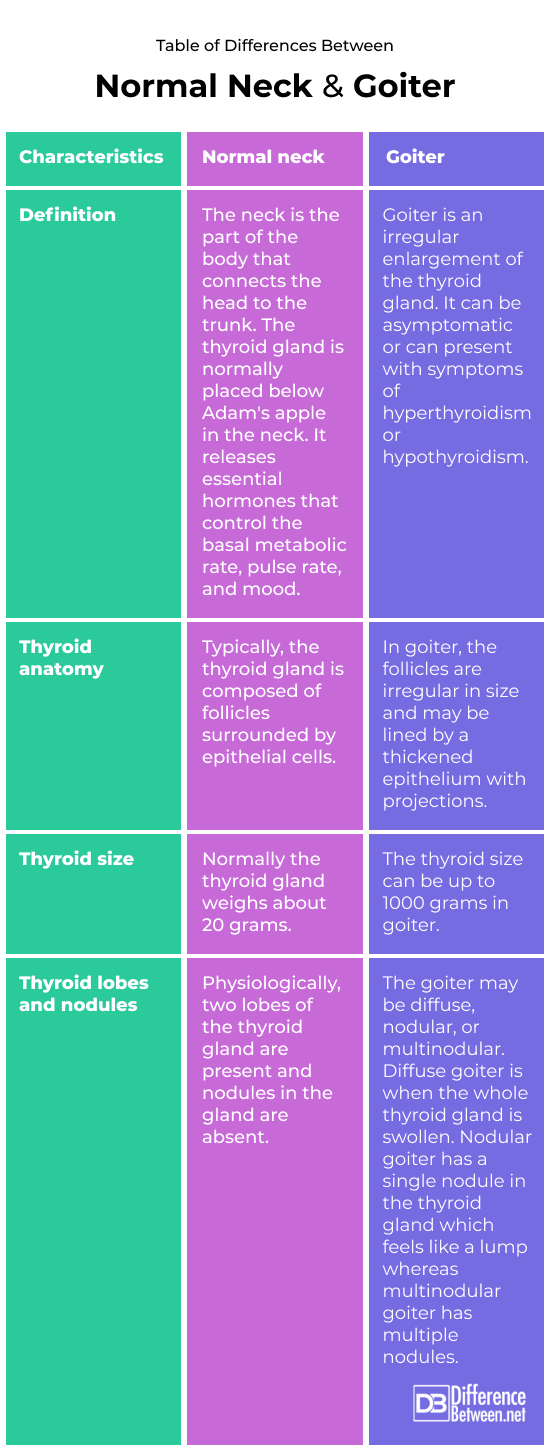Difference Between Normal Neck and Goiter
The thyroid gland is normally placed below Adam’s apple in the neck. It releases essential hormones that control the basal metabolic rate, pulse rate, and mood. Goiter is an irregular enlargement of the thyroid gland. It can be asymptomatic or can present with symptoms of hyperthyroidism or hypothyroidism.

What is a normal neck?
Definition:
The neck is a connection of the head to the trunk. The thyroid gland is normally placed below Adam’s apple in the neck. It releases essential hormones that control the basal metabolic rate, pulse rate, and mood.
Anatomy:
The neck contains several important structures such as the esophagus, trachea, thyroid and parathyroid glands, various muscles, layers of superficial and deep cervical fascia, and bones like cervical vertebrae and clavicles.
Thyroid anatomy:
Typically, the thyroid gland is composed of follicles surrounded by epithelial cells.
Thyroid size:
Normally the thyroid gland weighs about 20 grams.
Thyroid lobes and nodules:
Physiologically, two lobes of the thyroid gland are present and nodules in the gland are absent.

What is a goiter?
Definition:
Goiter is an irregular enlargement of the thyroid gland. It can be asymptomatic or can present with symptoms of hyperthyroidism or hypothyroidism.
Causes:
Causes of goiter include iodine deficiency, autoimmune diseases such as Grave’s disease and Hashimoto’s disease, thyroiditis, thyroid cancer, and pregnancy.
Symptoms:
Common symptoms associated with goiter include a swollen neck, difficulty breathing, hoarseness, and distended neck veins. Less commonly, the patient will have coughing, chest tightness, and dysphagia. Symptoms of hyperthyroidism such as tachycardia, sweating, weight loss, and anxiety can be seen in goiter. Also, symptoms of hypothyroidism can manifest with thyroid swelling. These include weight gain, cold clammy skin, menstrual irregularity, bradycardia, and constipation.
Thyroid anatomy:
In goiter, the follicles are irregular in size and may be lined by a thickened epithelium with projections.
Thyroid size:
The thyroid size can be up to 1000 grams in goiter.
Thyroid lobes and nodules:
The goiter may be diffuse, nodular, or multinodular. Diffuse goiter is when the thyroid gland is swollen. Nodular goiter has a single nodule in the thyroid gland which feels like a lump whereas multinodular goiter has multiple nodules.
Diagnosis:
Diagnosis of goiter is made after blood tests, thyroid hormone level analysis, thyroid ultrasound, thyroid scan, and radiologic investigations.
Treatment:
Asymptomatic goiter does not require treatment. In case of features of hyperthyroidism, antithyroid drugs are prescribed and levothyroxine is given if features of hypothyroidism are present. Other treatment options include radioactive iodine therapy and surgery.
Difference between Normal neck and Goiter
Definition:
The neck is a connection of the head to the trunk. The thyroid gland is normally placed below Adam’s apple in the neck. It releases essential hormones that control the basal metabolic rate, pulse rate, and mood. Goiter is an irregular enlargement of the thyroid gland. It can be asymptomatic or can present with symptoms of hyperthyroidism or hypothyroidism.
Thyroid anatomy:
Typically, the thyroid gland is composed of follicles surrounded by epithelial cells. In goiter, the follicles are irregular in size and may be lined by a thickened epithelium with projections.
Thyroid size:
Normally the thyroid gland weighs about 20 grams. The thyroid size can be up to 1000 grams in goiter.
Thyroid lobes and nodules:
Physiologically, two lobes of the thyroid gland are present and nodules in the gland are absent. The goiter may be diffuse, nodular, or multinodular. Diffuse goiter is when the whole thyroid gland is swollen. Nodular goiter has a single nodule in the thyroid gland which feels like a lump whereas multinodular goiter has multiple nodules.
Table of differences between Normal neck and Goiter

FAQs
Is it neck fat or goiter?
Neck fat is soft whereas goiter is firm and immobile.
How do you differentiate goiter?
Goiter is felt on physical examination. Blood tests and thyroid tests are needed to diagnose the condition.
What does a person with a goiter look like?
A person with a goiter will have a prominent swelling on the anterior neck. He may be obese, fatigued, and agitated in case of hypothyroidism or extremely thin, with flushed skin in case of hyperthyroidism.
What does the start of a goiter feel like?
Early goiter feels painless, and the patient may have chest tightness or difficulty breathing or swallowing.
What does your neck look like if you have a goiter?
A person with a goiter will have a prominent swelling on the anterior neck. It may be smooth or nodular in texture.
What does a goiter in the neck feel like?
Goiter feels like a painless, firm neck swelling. The patient may have chest tightness or difficulty breathing or swallowing.
How do I know if my neck is swollen from my thyroid?
The doctor will check you for thyroid swelling. If he suspects a goiter on physical exam, blood tests and radiologic investigations would be ordered.
Are goiters hard or soft?
Goiters are firm and painless.
What does your neck look like with thyroid problems?
The neck looks enlarged with thyroid problems and a lump is felt on the anterior neck.
- Differences Between Reptiles and Amphibians - May 17, 2024
- Difference Between Ophthalmology and Optometry - May 15, 2024
- Difference Between Fear and Anxiety - April 2, 2024
Search DifferenceBetween.net :
Leave a Response
References :
[0]Knudsen, Nils, et al. "Risk factors for goiter and thyroid nodules." Thyroid 12.10 (2002): 879-888.
[1]Hurley, Daniel L., and Hossein Gharib. "Evaluation and management of multinodular goiter." Otolaryngologic Clinics of North America 29.4 (1996): 527-540.
[2]Knudsen, Nils, et al. "Risk factors for goiter and thyroid nodules." Thyroid 12.10 (2002): 879-888.
